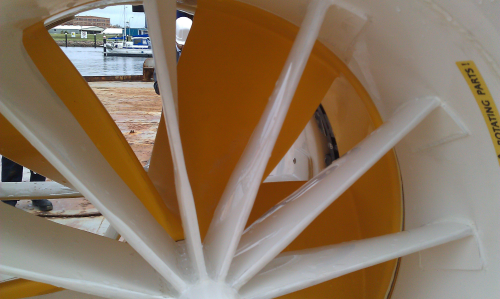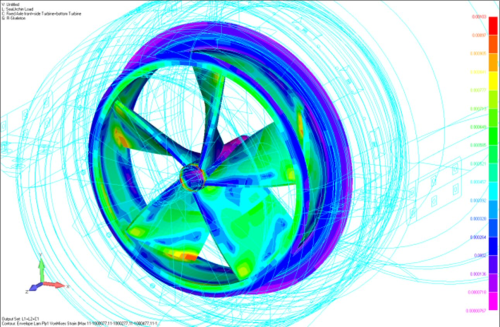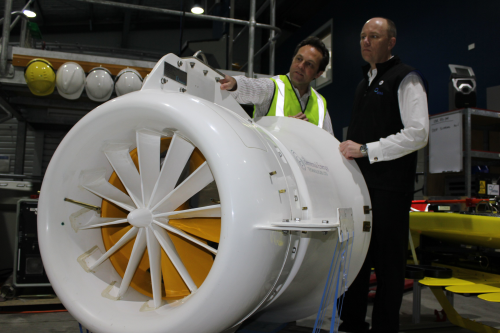


Global attention on renewable energy generation is heavily focused on wind, solar, geothermal, wave and the relatively new fields of ocean current, tidal and river power. Of these green energy sources only oceans, tides and rivers (hydro-kinetic energy) and the geothermal sector have the potential to compete directly with nuclear and coal powered generators for the supply of predictable or baseload electricity.
Elemental Energy Technologies Ltd (EET), based in Sydney, Australia, is well positioned to be a leading hydrokinetic energy technology developer with its third generation SeaUrchin vortex turbine. It was developed over six years by a team of Australian design engineers led by inventor Michael Urch and including RPC Technologies, an Australian designer and manufacturer of composite components. This hydrokinetic reaction turbine generates electricity by harnessing the virtually inexhaustible and predictable kinetic energy from free-flowing ocean streams, tides and flowing rivers. No dams or barrages are necessary, thus reducing environmental impact.
The SeaUrchin’s design
The SeaUrchin consists of three distinct components: stator; rotor; and ejector. The turbine is placed in a river or ocean with a steady flow of water, and energy in the flowing water is captured and converted as it passes through the spinning rotor which is directly connected to the sealed generator. A stator is positioned in front of the rotor to maximise the torque on the rotor and to ensure axial fluid flow out of the rotor. An ejector is positioned behind the rotor to maximise the amount of water that passes through the rotor, thus increasing the total electrical power output.
This design enables customisation for a wide range of flow rates and it can operate efficiently in very low flow rates (down to as low as 1.5 m/s) where conventional designs cannot, making it deployable in a wide range of locations around the world. The SeaUrchin is designed to be self-aligning to the direction of the prevailing water flow.
In some models, a rim mounted electrical generator is integrated into rotor and stator components. In other designs, ‘off-the-shelf’ generator and gearbox components can be incorporated to enhance reliability and reduce the long term cost of electricity (LCoE) generated. The electrical design of the generator may either be a permanent magnet or induction type depending on the application. Permanent magnet designs are preferred for simple stand-alone installations (rivers and streams) while induction designs are preferred for grid connected arrangements and large arrays (tidal and ocean streams).
Integrated controls and remote monitoring of the turbine performance for larger Sea-Urchin models will enable variation of the generator load to match available free flow velocities to optimise turbine performance.
“The turbine extracts up to four times more power and is up to 70% more efficient than conventional un-shrouded ‘blade-based’ marine generators commonly in development and under trial today ,” says the SeaUrchin’s designer Michael Urch.
“It deploys as few as one moving part and uses off-the-shelf components in the largest utility-scale models.”
Composite construction
The prototype 2 kW SeaUrchin currently being tested is about 1.2 m long with an overall diameter of approximately 1.1 m. A feasibility study has been finalised for a 1 MW utility-scale turbine which is approximately 15 m long and 9.5 m in diameter at the intake. All of the structural elements are made out of composites, with only the electrical, shaft and bearings of other materials.
RPC Technologies was in charge of researching and advising on the composites utilised in the turbine.
The design is based on a clever assembly of thin shells made of glass fibre/vinyl ester laminate. Epoxy vinyl ester resin (Ashland’s Hetron 922, supplied by Nuplex Composites) was chosen for its high corrosion resistance to marine environments as well as for its mechanical properties. Glass fibre was selected for cost reasons. Through an extensive development using finite element analysis (FEA), the lay-up structure of the SeaUrchin was defined using chopped strand mat (CSM), woven roving (WR) and unidirectional (UD) glass reinforcement. The components were then foam filled in situ using a cellular epoxy foam system to obtain the global rigidity required for the application. Thanks to this design the SeaUrchin presented anti-corrosion and structural properties necessary to fulfil its operating requirements.
For the prototype SeaUrchin RPC Technologies used simple but versatile processes, mainly hand lay-up, with some consolidation by compression. The moulds were made in-house from CNC machined foam patterns and manufactured out of glass/vinyl ester laminate reinforced with plywood.
| The long-term cost savings resulting from our choice of state-of-the-art composite materials will result in cheaper electricity despite the harsh environment that SeaUrchins will operate in. |
| Michael Urch, SeaUrchin designer |
The materials used in the SeaUrchin are required to resist permanent exposure to a harsh marine environment. This placed a limit on the possible materials which could be used. In designing the turbine, RPC was able to specify composites used widely in boat building as these are readily available and inexpensive compared with carbon fibre composites that are used in some other designs. Taking into account the materials cost and the processing cost, the composites structure selected was the most cost effective solution as well as the most practical given the particular requirements for the SeaUrchin. Also, because the design incorporates fully-supported blades, costly exotic composites such as carbon fibre were not required for blade strength.
With its extensive use of these proven composite materials, the SeaUrchin can be mass produced and is easier and cheaper to deploy. The use of composites has also significantly reduced long-term costs by extending service life and reducing maintenance costs.
“The long-term cost savings resulting from our choice of state-of-the-art composite materials will result in cheaper electricity despite the harsh environment that SeaUrchins will operate in,” says Urch.
The SeaUrchin project was awarded a national Engineering Excellence award by Engineers Australia having been overall winner and winner of the UGL sponsored Award for Innovation in Sustainable Engineering at the regional Newcastle Division awards in May 2012.
EET was also a semi-finalist in the 2012 Australia CleanTech Open Competition and was a presenter at the 2012 CleanTech Open Global Forum held in Silicon Valley, San Jose, California, USA, in November 2012.
Australian development
EET recently signed an agreement with tidal energy developer Tenax Energy Pty Ltd, Darwin, Australia, to install and trial the SeaUrchin device in Darwin’s Tropical Tidal Energy Testing Centre (T3C), signalling the start of a tidal energy industry in Australia.
The project will see the establishment of a 2 MW pilot plant and an associated Research and Tropical Tidal Testing Centre during 2013/2014.
| Watch a video about the SeaUrchin tidal turbine here. |
It is envisaged the pilot plant will then move towards a 10 MW pilot array (multiple devices) followed by the development of a generation facility that will deliver affordable renewable power to the people of Darwin. The project is expected to be generating electricity by 2015, and reach commercial scale before the end of the decade.
According to EET’s Douglas Hunt: “This agreement represents a major milestone in Australia’s progress to become one of the world’s leading tidal energy generators. It is also an ideal opportunity for Elemental Energy Technologies to showcase its SeaUrchin turbine technology to the world.”
“The T3C assists local companies like ours to develop their technology using Australia’s highly trained workforce and experts in their field such as RPC Technologies to develop world leading products in Australia,” he adds.
“The T3C will help keep expertise in Australia and generate future royalty earnings.” ♦
Also see:
This article was also published in the March/April 2013 issue of Reinforced Plastics magazine.
The digital edition of Reinforced Plastics is distributed free of charge to readers who meet our qualifying criteria. You can apply to receive your free copy by completing the registration form.





